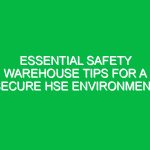Introduction
In the realm of Health, Safety, and Environment (HSE), the significance of having a well-structured safety sheet example cannot be overstated. A safety sheet serves as a critical document that outlines essential safety information related to hazardous substances, workplace safety protocols, and emergency procedures. It is a vital tool for ensuring the safety of employees, the protection of the environment, and compliance with relevant regulations. In this article, we will explore the key components of a safety sheet example, its importance in the HSE domain, and best practices for creating effective safety sheets that can be utilized across various industries.
Understanding Safety Sheets in the HSE Context
Before delving into specific examples, it is essential to understand what constitutes a safety sheet and its role within the HSE framework. A safety sheet, commonly known as a Safety Data Sheet (SDS), is a document that provides detailed information about a chemical or substance. It is designed to inform users about the properties of the substance, the hazards associated with it, safe handling practices, and emergency measures in case of exposure or spills.
Safety sheets are not just a regulatory requirement; they are vital for fostering a culture of safety within organizations. By ensuring that employees have access to accurate and comprehensive safety information, organizations can significantly reduce the risk of accidents and enhance overall workplace safety.
Key Components of a Safety Sheet Example
Creating an effective safety sheet example involves incorporating several critical elements. Below, we will detail the essential components that should be included in any safety sheet.
1. Identification of the Substance
The first section of a safety sheet should clearly identify the chemical or substance. This includes the following information:
- Product Name: The common name of the substance.
- CAS Number: The unique identifier assigned to the substance.
- Manufacturer Information: Name, address, and contact details of the manufacturer or supplier.
2. Hazard Identification
This section outlines the potential hazards associated with the substance. It should include:
- Classification: How the substance is classified according to regulatory standards (e.g., flammable, toxic).
- Signal Words: Words such as “Danger” or “Warning” to indicate the level of hazard.
- Hazard Statements: Clear descriptions of the nature of the hazards (e.g., “Causes skin irritation”).
3. Composition/Information on Ingredients
This part details the ingredients of the substance, providing information on their concentrations and any impurities that may pose health risks. It is crucial for safety assessments and understanding the potential dangers associated with exposure.
4. First-Aid Measures
Providing clear and concise first-aid measures is vital. This section should include:
- Inhalation: Steps to take if someone inhales the substance.
- Skin Contact: Recommended actions for skin exposure.
- Eye Contact: Procedures for dealing with exposure to the eyes.
- Ingestion: Guidance on what to do if the substance is ingested.
5. Fire-Fighting Measures
This section outlines appropriate firefighting techniques and the types of extinguishing media that should be used. It is essential to include information on any specific hazards related to combustion, such as toxic gases.
6. Accidental Release Measures
In the event of a spill or leak, having a clear plan is crucial. This section should detail:
- Personal Precautions: Recommended protective equipment for responders.
- Environmental Precautions: Measures to prevent environmental contamination.
- Containment and Cleanup: Procedures for containing and cleaning up the spill.
7. Handling and Storage
Guidelines on safe handling and storage practices are essential to prevent accidents. This section should cover:
- Safe Handling Practices: Instructions for safe use of the substance.
- Storage Conditions: Recommendations for how and where to store the substance safely.
8. Exposure Controls/Personal Protection
This section should identify any exposure limits and recommend personal protective equipment (PPE) necessary when working with the substance. This includes:
- Engineering Controls: Ventilation and other measures to minimize exposure.
- PPE: Specific types of protective gear required (gloves, masks, goggles).
9. Physical and Chemical Properties
Providing detailed information about the substance’s physical and chemical properties helps users understand its behavior in different conditions. This includes:
- Appearance: Color and form of the substance.
- Odor: Smell characteristics.
- Boiling Point: Temperature at which the substance becomes vapor.
- pH: Acidity or alkalinity of the substance.
10. Stability and Reactivity
This section describes the stability of the substance and any conditions that may lead to hazardous reactions. It is essential to note incompatible materials and potential decomposition products.
11. Toxicological Information
Understanding the toxicological effects of a substance is crucial for assessing health risks. This section should cover:
- Routes of Exposure: How the substance can enter the body (inhalation, skin contact).
- Symptoms: Possible health effects associated with exposure.
Best Practices for Creating Effective Safety Sheets
When developing a safety sheet example, certain best practices can enhance its effectiveness. Here are some actionable guidelines:
1. Keep it Clear and Concise
Safety sheets should be straightforward and easy to understand. Avoid technical jargon where possible, and ensure that all information is presented clearly.
2. Use Consistent Formatting
Employing a uniform format for all safety sheets within an organization helps users quickly locate necessary information. This includes using headings, bullet points, and tables to present data.
3. Regularly Update Information
Safety sheets should be reviewed and updated regularly to reflect any changes in regulations, substance formulations, or safety protocols. This ensures that employees always have access to the most current information.
4. Provide Training
Simply having safety sheets is not enough. Organizations should provide training to employees on how to read and interpret safety sheets. This training can significantly enhance workplace safety.
5. Make Safety Sheets Accessible
Safety sheets should be readily available in locations where hazardous substances are used or stored. Consider electronic formats for easy access and distribution.
Regulations and Standards Governing Safety Sheets
The creation and distribution of safety sheets are heavily regulated in many jurisdictions. Understanding these regulations is critical for compliance and safety.
1. OSHA Regulations
In the United States, the Occupational Safety and Health Administration (OSHA) mandates the use of Safety Data Sheets for hazardous chemicals. Employers must ensure that these sheets are accessible to all employees.
2. GHS Compliance
The Globally Harmonized System of Classification and Labelling of Chemicals (GHS) establishes a standardized approach to classifying chemicals and communicating their hazards. Safety sheets must adhere to GHS guidelines to ensure consistency across borders.
3. REACH Regulation
In the European Union, the Registration, Evaluation, Authorisation, and Restriction of Chemicals (REACH) regulation requires detailed safety information for chemical substances. This regulation emphasizes the need for comprehensive safety sheets as part of the substance registration process.
Real-Life Example: Effective Safety Sheet Implementation
To illustrate the impact of a well-crafted safety sheet, consider the case of a manufacturing company that experienced a chemical spill. The safety sheet for the involved substance provided clear information on the appropriate containment measures, personal protective equipment, and emergency contacts. Due to the well-structured safety sheet, the employees were able to respond swiftly and effectively, minimizing the spill’s impact and ensuring everyone’s safety.
In contrast, another organization faced severe consequences when its safety sheets were outdated and poorly formatted. Employees struggled to find essential information during an emergency, leading to increased exposure and potential health risks. This situation underscores the critical need for effective safety sheet management in the HSE context.
Conclusion
In conclusion, safety sheets play a pivotal role in promoting health, safety, and environmental sustainability within organizations. By providing essential information about hazardous substances, safety sheets empower employees to work safely and respond effectively in emergencies. Creating a comprehensive safety sheet example involves careful attention to detail, clear communication, and ongoing training. Organizations must prioritize the development of robust safety sheets to foster a culture of safety and compliance.
As we move forward, it is imperative for organizations to continuously evaluate and improve their safety sheet practices. By doing so, they not only comply with regulations but also contribute to a safer and more environmentally responsible workplace. The importance of safety sheets in the HSE domain cannot be understated, and organizations must take proactive steps to ensure their effectiveness and accessibility.


